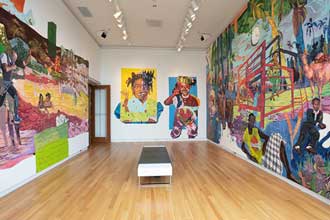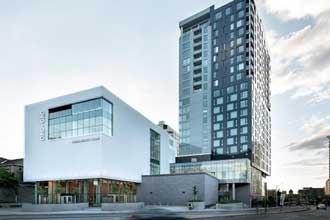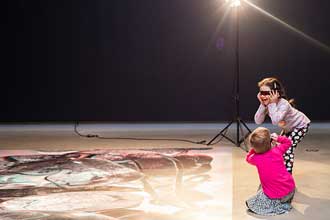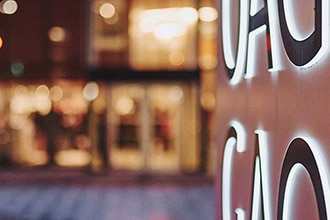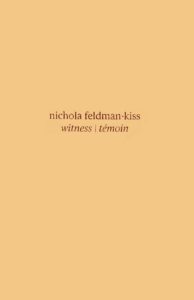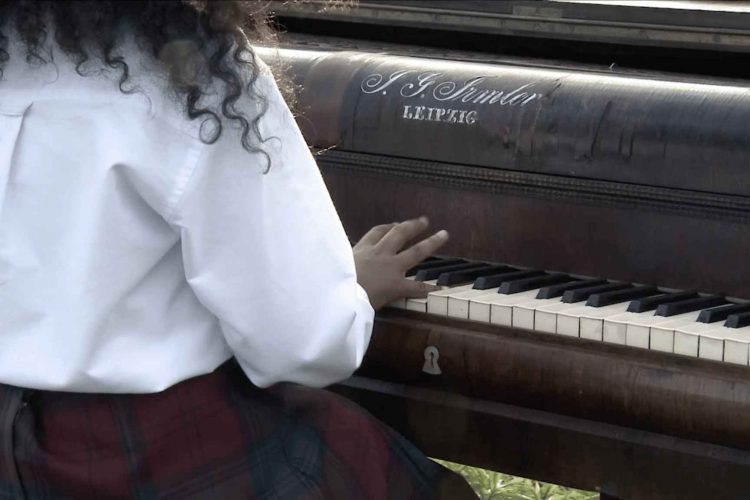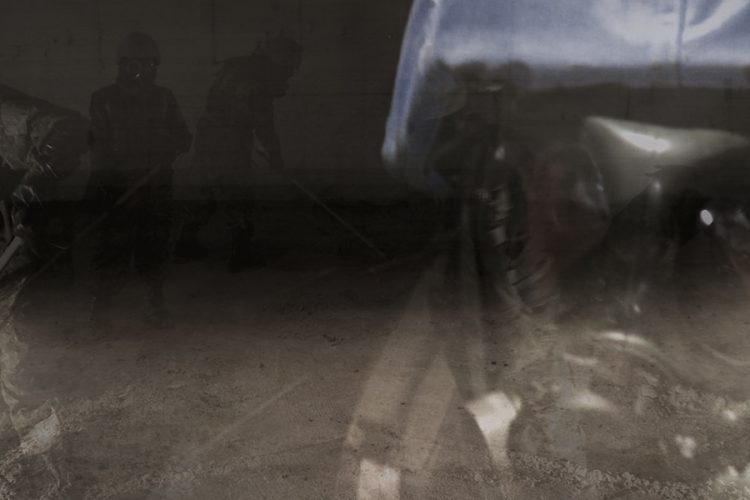nichola feldman-kiss \ after Africa
March 4, 2023
- June 11, 2023
“So long, Farewell” (sunset) / a yard of ashes (continuous cross dissolve) / “Oh! How I hate to get up in the morning!” (sunrise)
Level 4
after Africa is a seminal work in the practice of artist nichola feldman-kiss. The three-channel audio/video installation brings together key symbols drawn from the artist’s autobiography. The artwork reflects a sustained artistic inquiry into Colonial frameworks while focusing on the body as a contested site of cultural production.
Aspiring towards deeper understanding for those of us born into peacetime, the three videos of after Africa work together to build empathic bridges to the experiences of so many Canadians who continue to live the difficult aftermaths of conflict culture. Symbols abound. Every choice is deliberate.
Two bookending videos are set in a lush green field where well-nourished cattle graze contentedly in the late summer sun. In the middle of the field, a cinema-style dolly rail encircles a 19th-century square piano where an Afro-diaspora girl child sits in disciplined recital. She wears a Colonial-style school uniform: Oxford cloth shirt, pleated plaid skirt, patent leather shoes. The rigid uniform presents a stark contrast to her wildly curly hair let loose and free to the breeze. The child is cast in reference to the artist’s maternal lineage, which is inextricably entangled with the genetic legacy of Colonial conquest; intention to genocide the Indigenous Caribs; and the industrial enslavement of folks stolen from Africa. The piano insignia “Made in Leipzig” points to the city from which the artist’s paternal family fled mid-century Germany’s racial purity laws for refuge as British subjects within the Empire’s Caribbean Colonies.
While the camera performs rounds staged in the surreal tree-lined set, the child plays rounds. To the left, she plays to the tune “So Long, Farewell” from Rodgers and Hammerstein’s 1959 WWII musical, The Sound of Music. To the right, she plays “Oh! How I hate to get up in the morning!,” a popular wartime anthem composed by Irving Berlin from the trenches of WWI (1918). The two songs are symbolic keys to the artist’s own naive understanding of war and displacement. As the sun sets and the sun rises, respectively on the left and the right videos, the camera rounds the child again and again. All the while she practises with increasing discipline to render a perfect tune. The field surrounds the dolly rail. The rails surround the piano. Supported by a chorus of field crickets, the pianist plays in rounds. The sun sets and the sun rises.
The central video shows the artist performing in continuous cross-dissolve. The looping video features a blue-helmeted peace worker fully clad and masked in personal protective equipment, armed with a wide red-bristled broom, fully engaged in perpetual sweeping. “The breath is laboured, the gesture is determined. Sounds of approaching Antonov engines signal danger. Sudden violence erupts outside the frame. The sweeper keeps sweeping. The last cry is abruptly silenced. We are returned to the sweeper’s fatigued but no less determined gesture. The breath is laboured. The broom is heavy. Futility seeps through the cracks among aural and visual elements.”¹
The weight of the task mingles with the child’s determined progression through the notes. The cycles of global geopolitical conflict reverberate through the many successes and failures of Empire.
The blend of these sounds and images evoke the complexity of what it means to be here in Canada with a protected view to the global stage of want and war. after Africa, thick with symbolic keys, helps us to consider how the legacy of Colonial violence implicates our bodies as contemporary participants of Canadian society. The artwork excavates the intermingling of histories physically within our bodies and invites us to enter into relationship with those experiencing human indignity—as shock, as banality, as active trauma, and as traumatic memory of aftermath.
nichola feldman-kiss is a first-generation Canadian of the Caribbean diaspora and a repatriated citizen of Germany and Jamaica. Their ancestral lineage includes those who adventured, forced, got entangled, profited, and endured migrations across oceans and continents. Activism in feldman-kiss artworks is toward the understanding of one’s own body as a place of history. Their artworks commingle pasts with presents as poetic portals into experiences of everyday contemporary folks who bear the brunt of Colonial world order.
For the research and creation of after Africa, feldman-kiss worked with the Canadian Armed Forces to stage a performance of peacekeeper within the complex project that was the 2011 United Nations Mission in Sudan. They sought first-hand sensorial experience to better understand how history is contained in present day geopolitical dramas. Embedded within international teams of UN Military Observers, the tour enabled the artist to bear insider witness to the troubling experiment with State building, extreme political chaos, and the paradox of famine upon such rich and fertile ground.
after Africa is nichola feldman-kiss’s first work in a complex body of artworks created 2010–2015 in response to their journey into the UN Mission and follow-up study of human violence.
¹ nichola feldman-kiss, Artist’s Website. Retrieved December 23, 2022. https://www.nicholafeldmankiss.com/warartist/so-long-farewell.html.
About the artist
nichola feldman-kiss creates across disciplines with emphasis on relational, lens, and hybrid media technologies presented as social engagement, institution intervention, and public installation. In the 25 years since obtaining their MFA from California Institute of the Arts, nichola has built a rigorous and well respected critical art practice. Their art and technology innovations and institution interventions have been hosted by the National Research Council of Canada, the Ottawa Hospital Eye Institute, the Department of National Defence, and the United Nations, among others. Born, raised and having raised family in Ottawa (Odawa), the artist now lives and works between Toronto (Tkaronto) and coastal Newfoundland (Ktaqmkuk), where they are pursuing artistic engagement with the Atlantic Ocean. after Africa, part of the OAG’s Permanent Collection, was included in the OAG’s 2015 mid-career retrospective exhibition, nichola feldman-kiss witness / témoin.
Gratitude
Deborah Dawit (pianist)
Ruth Dawit (girl in the field)
Victor Poirier (camera)
Roland Simmons (sound recording)
Christion Schnobb (dolly/grip)
Andrew Smith (production assistant/dolly)
Edward Folger (editor)
Department of National Defence and the Canadian Armed Forces
The United Nations Mission in Sudan
Canada Council for the Arts
Ontario Arts Council
City of Ottawa
Credits
Curator: Catherine Sinclair
Text: Catherine Sinclair with nichola feldman-kiss
Exhibition design: nichola feldman-kiss with Leah Ross
Technical team: Jennifer Gilliland and Dan Austin
The Ottawa Art Gallery acknowledges the support of the City of Ottawa, the Ontario Arts Council, and the Canada Council for the Arts.
nichola feldman-kiss: witness / témoin
Texts by Michelle Gewurtz, Catherine Sinclair, Robert Enright, and Sara Matthews
This exhibition publication provides a comprehensive overview of nichola feldman-kiss’ work over the last fifteen years.
Year of publication: 2016
Bilingual, in English and in French
Images
Tour the Exhibition
Related Events
An in-person discussion between artist nichola feldman-kiss, and OAG Deputy Director, Chief Curator, Catherine Sinclair Join us for an artist...
Additional Resources
Please click tags for both English and French content.

